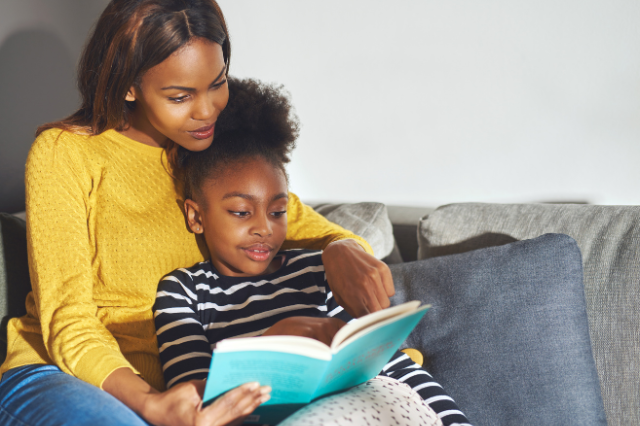How does dialogic reading help language development?
Brianna Stodgell, CCC-SLP
Reading books with your children is a great way to increase their language skills, specifically a practice called Dialogic Reading. In this post we will explore, How Does Dialogic Reading Help Language Development, and ways that you can practice it in your home.
How Does Dialogic Reading Help Language Development:
There are many ways to promote language development through everyday life and routines. Even as a Speech Language Pathologist, I sometimes need to remind myself that we do not always need fancy toys or creative activities in order to make an impact on a child’s language development. One simple, low-cost activity that can be done to promote language facilitation is shared story time. Studies show that regularly using the specific technique of Dialogic Reading during story time has significant positive effects on oral language and overall literacy abilities. Dialogic Reading is an interactive shared picture book reading practice designed to enhance young children’s language and literacy skills. During the shared reading practice, the adult and the child switch roles so that the child learns to become the storyteller with the assistance of the adult who functions as an active listener and questioner.
Dialogic Reading Involves the Following Prompts (CROWD):
Completion: child fills in blank at the end of a sentence.
Recall: adult asks questions about a book the child has read.
Open-ended: adult encourages child to tell what is happening in a picture
Wh-: adult asks “wh-” questions (who, what, where, when, why) about the pictures in books.
Distancing: adult relates pictures and words in the book to children’s own experiences outside of the book.
These prompts can be either simplified or advanced to ensure parents are meeting the child where they are in regard to their current skills and abilities. These prompts are used by the adult in a reading technique called PEER:
P: adult prompts the child to say something about the book.
E: adult evaluates the response
E: adult expands the child’s response
R: adult repeats the prompt.
Progression of Dialogic Reading and Language Development:
When using these strategies, parents can go beyond just reading to their children and involves the child in story time, even before they are able to read words. It is best to repeat this method with books the child is already familiar with until they begin to master skills. As adults regularly use these strategies and the child becomes increasingly more familiar with the books presented, the adult reads less, listens more, and gradually uses more higher level prompts to encourage the child to go beyond naming objects in the pictures to thinking more about what is happening in the pictures and how this relates to the child’s own experiences.
Benefits of Dialogic Reading for Language Development:
Dialogic Reading has been shown to have numerous benefits for children's language development, including the following:
Increased vocabulary: Through dialogic reading, children are exposed to new words and concepts that they may not encounter in their everyday lives. By discussing the meaning of these words and concepts, children are more likely to remember and use them in their own language.
Improved comprehension: By engaging in a conversation about the book, children are better able to understand the story and its meaning. This can lead to improved reading comprehension skills and a deeper understanding of the world around them.
Increased critical thinking skills: Dialogic reading encourages children to think deeply about the story and to ask questions. This can help children develop critical thinking skills, such as the ability to analyze information and make connections between different ideas.
Improved social skills: By engaging in a conversation with an adult or other children, children develop social skills such as turn-taking, active listening, and communication.
Increased motivation to read: By making reading a fun and interactive activity, children are more likely to develop a love of reading and to see it as an enjoyable activity rather than a chore.
Overall, dialogic reading is an effective technique for promoting children's language development and improving their reading skills. By engaging children in a conversation about a book, adults can help children develop a deeper understanding of language and the world around them.




